Their Majesties the Emperor and Empress
I

(Photo: Imperial Household Agency)
On 7 January 1989, upon the demise of Emperor Hirohito (posthumously Emperor Showa), His Majesty Emperor Akihito acceded to the throne as the 125th Emperor of Japan. The Ceremony of Enthronement was held at the Imperial Palace on 12 November 1990. From abroad, representatives of 158 countries, including Monarchs and Heads of State, and of two international organizations attended the ceremony.
As stated in the Constitution of Japan, the Emperor is "the symbol of the State and of the unity of the people" and derives his position from "the will of the people with whom resides sovereign power."
Emperor Akihito was born in Tokyo on 23 December 1933, to the great joy of the entire nation, as the first son of Emperor Showa and Empress Kojun. He has four elder sisters, one younger brother and one younger sister.
His Majesty received his elementary and secondary education at Gakushuin, the then Imperial Household Ministry school which later became a private institution. While he was in the elementary school, he had to move temporarily out of Tokyo with his classmates because of the war. He was still in the mountains of Nikko when the war came to an end in 1945.
In 1952, he entered Gakushuin University's Faculty of Political Science and Economics. In the same year, his Coming-of-Age Ceremony and his Investiture as Crown Prince were held. He thus began to carry out official duties in his capacity as Crown Prince. The next year, he made his first overseas journey to attend the coronation of Queen Elizabeth II of the United Kingdom, and travelled extensively in North America and Europe. He completed his university education as a special student in 1956.
In addition to his formal education, Emperor Akihito received special tutoring from authorities in various areas of learning, such as Japanese History and Constitutional Law.

(1959)
at their marriage.
(Photo: Imperial Household Agency)
On 10 April 1959, Crown Prince Akihito married Miss Michiko Shoda, daughter of a distinguished businessman. Dr. Shinzo Koizumi, who supervised the Crown Prince's education for many years, said of this marriage: "The Crown Prince chose her, and so did we." In accordance with the Imperial House Law, the Imperial House Council, headed by the Prime Minister, gave its unanimous consent to the marriage. The whole nation was enchanted by the traditional wedding ceremony and the splendid open horse-carriage procession that followed. It was one of the happiest days in the history of post-war Japan.
Crown Prince Akihito, with warm and devoted support from Crown Princess Michiko, pursued his official duties with renewed vigour, faithfully observing the time-honoured Imperial tradition and, at the same time, opening up new areas of activity befitting the role of the Crown Prince in the modern era.
Following his strong encouragement, the National Sports Games for the Disabled was initiated in 1965, bringing broader opportunities for the disabled to play their full role in society. An annual prize for outstanding work in the care of handicapped children was created with the support of the Crown Princess. The Crown Prince and Crown Princess met all the Japanese Overseas Cooperation Volunteers before they departed for their work in developing countries and followed their work with great interest thereafter. A Crown Prince Scholarship was created for student exchange between Japan and Hawaii where descendants of a large number of Japanese emigrants live.
As Crown Prince and Crown Princess, they visited 37 countries in all the regions of the world, in most cases on behalf of the then Emperor and Empress. They generated an enormous amount of goodwill in the countries they visited, as people came to appreciate their unassuming and sincere personalities.
II
Empress Michiko was born in Tokyo on 20 October 1934 as the first daughter of Hidesaburo and Fumiko Shoda. The Shoda family is prominent in both industrial and academic circles, counting among its members two recipients of the Order of Culture, the highest order given to scholars and artists by the Emperor. At the time of her marriage to the Crown Prince, the nation expressed approval and satisfaction on learning of the family's simple and dignified way of life.
Miss Shoda attended Futaba Elementary School. She was obliged to leave the school when she was in the fourth grade, as the ravages of war made living in Tokyo difficult. She returned to Tokyo to graduate from her old school after the war ended. She then attended Seishin (Sacred Heart) High School and entered the Department of Foreign Languages and Literature in the Faculty of Literature at the University of the Sacred Heart. In her senior year, she was elected, upon nomination by her classmates, president of the student government. Many of her classmates recall that, though very reserved, she won full cooperation from her fellow students and helped to introduce a harmonious spirit into University life. At the ceremony of her graduation in 1957 she was valedictorian.
As Crown Princess, she deepened her understanding of problems existing in society through meetings with leading figures representing various spheres of activity. In her modest and self-effacing manner, she was once heard to say that she, as a member of the Imperial Family, would like to remain a person who follows with concern what is happening in society, keeping the people and their needs close to her heart and constantly praying for their well-being.
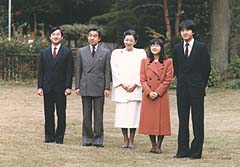
(1981)
(Photo: Imperial Household Agency)
The Crown Prince and Crown Princess established a happy family with their three children, Prince Naruhito, Prince Fumihito and Princess Sayako.
In spite of her busy life, the Crown Princess brought her three children up herself with loving care. She breast-fed all of them, and when the children were of school-age, it was she herself who prepared their lunch-boxes early every morning. Later, she said about her approach to child-raising: "I have consulted the Emperor (then the Crown Prince) on every matter and I am grateful to him for the precious advice he gave me, based on his own experiences, which was most helpful to me."
As the Emperor mentioned at one of his press conferences, the Empress has always loved and respected his relatives, above all his parents. As Crown Princess, her constant visits with the Crown Prince and their children to Emperor Showa and Empress Kojun gave them much joy. Since Emperor Showa passed away, Empress Michiko, together with Emperor Akihito, continued to visit Empress Kojun almost every weekend, until Empress Kojun passed away on 16 June 2000.
III
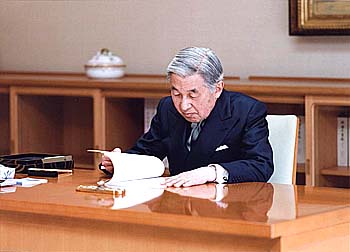
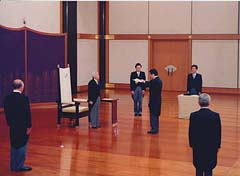
(Photo: Imperial Household Agency)
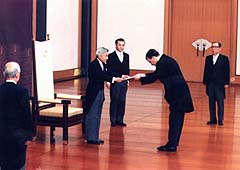
(Photo: Imperial Household Agency)
The Emperor performs those acts in matters of state which are provided for in the Constitution, such as appointing the Prime Minister and the Chief Justice of the Supreme Court, attesting the appointment of Ministers of State and some other high officials, convoking the National Diet, promulgating laws and treaties, awarding honours, attesting the credentials of ambassadors as well as receiving foreign ambassadors. In these matters of state, he acts on the advice and approval of the Cabinet.
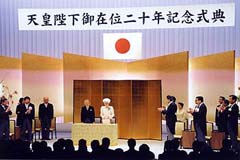
(2009)
(Photo:Imperial Household Agency)
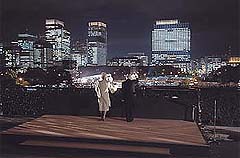
(2009)
(Photo:Imperial Household Agency)
Since the Enthronement in 1989, the Emperor, together with the Empress, has been discharging a wide variety of official duties in relation to his position as the symbol of the State and of the unity of the people. The twentieth Anniversary of the Enthronement of the Emperor was celebrated in 2009 with a number of commemorative ceremonies and colourful events involving people from various walks of life. With their strong sense of duty and constant attention to the real needs of the people, Their Majesties have brought the Imperial Family much closer to the general public with unfailing dignity.
At the Imperial Palace, Their Majesties host hundreds of ceremonies, audiences, teas, lunches, and dinners all year around. On these occasions, they meet a large number of people from all walks of life, including government officials, local government leaders, businessmen, farmers and fishermen, social and welfare workers, scholars and artists. State Banquets for visiting Heads of State or lunches and audiences for other visiting dignitaries are also held at the Imperial Palace.
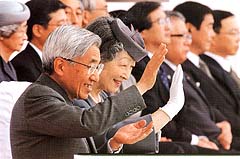
(Photo: Kyodo News)
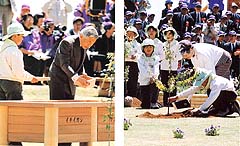
(Photo: Oita Prefecture)
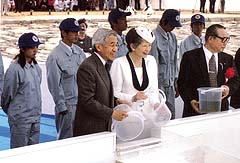
(Photo: Kyoto Prefecture)
Their Majesties have visited all 47 prefectures and many of the remote islands of Japan. They make at least three domestic trips every year, attending the National Sports Festival, the National Arbour Day Festival and the Cherished Sea Festival, which are held in different prefectures in rotation. The last two festivals have the theme of promoting forestry and fisheries while protecting the natural environment. On their domestic trips, besides meeting the community leaders, they always visit welfare, cultural or industrial facilities to give encouragement to the local people involved. Especially concerned about welfare, they have visited more than 500 facilities for children, the elderly and the handicapped throughout the country.
(1995)
(Photo: Mainichi)
They visit areas struck by major natural disasters, to console the victims and to give support to the rescue workers. In January 1995, they flew to Hyogo Prefecture after the Great Hanshin-Awaji Earthquake as soon as local conditions made it possible. On the day of the trip, by plane, by helicopter and by mini-bus, they visited several widely separated places in the disaster area from early in the morning until late in the evening. They always follow the situation in the disaster areas until full recovery is confirmed; for example, in April 2001, they inspected the state of the recovery of the area affected by the Great Hanshin-Awaji Earthquake of 1995. Following the Great East Japan Earthquake, which struck on March 11, 2011, Their Majesties made visits to evacuation centers and the disaster-affected areas on seven consecutive weeks from March to May, where they offered their sympathies to the people who had been affected by the disaster.
Since the Emperor's enthronement, Their Majesties have so far made official visits to 28 countries, bringing the number of countries they have visited to 51.
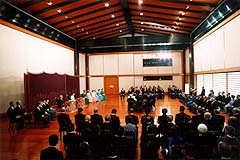
(Photo: Imperial Household Agency)
Their Majesties compose waka (a classical form of poetry dating back to the 8th century Manyo-shu Anthology), an age-old tradition in the Imperial Family. Their Majesties published a collection of their waka when they were Crown Prince and Crown Princess, and, in 1997, upon a strong request from people concerned, a collection of the Empress's waka of more recent years was published. Every January, the Emperor hosts the traditional New Year's Poetry Reading at the Palace. In this ceremony, ten waka out of about 20,000 composed and submitted to the Emperor by ordinary citizens are chanted in the traditional way, together with waka composed by Their Majesties and other members of the Imperial Family.
(Photo: Imperial Household Agency)
Every year, following the example of his father, Emperor Showa, who initiated the practice in 1927, the Emperor himself plants and harvests rice, the traditional main crop in Japan, at the paddy-field in the Palace Grounds.
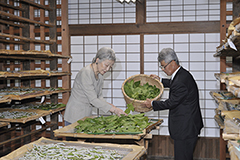
(Photo: Imperial Household Agency)
The Empress raises silkworms at the Palace sericulture centre, with the help of several staff-members, feeding them with mulberry leaves, following the precedent set in 1871 by Empress Dowager Shoken, Empress and consort of the great-grand-father of the Emperor. Some of the silk thus produced is used for a revival of old textile material of historical value kept by the Imperial Family at the Shosoin Repository in Nara since the 8th century when it was the capital of the country.
On certain days of the year determined by tradition, Their Majesties pay their respects to the Imperial ancestors at the Palace Sanctuary, and pray for the happiness and welfare of the people.
IV
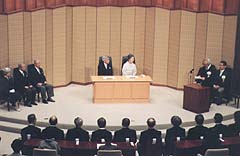
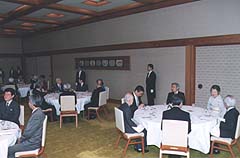
Their Majesties' interests encompass broad areas of learning and culture. They attend annual award ceremonies of the Japan Academy and the Japan Academy of Arts. They often receive scholars and artists including the members of the Academies as well as the recipients of the Order of Culture at the Imperial Palace. They also attend ceremonies for the awarding of important scientific prizes, as well as international scientific conferences held in Japan.
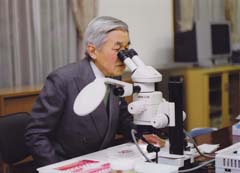
(Photo: Imperial Household Agency)
The Emperor has a keen interest in natural life and its conservation. He encourages research projects on natural life in the grounds of the Imperial estates.
For many years, the Emperor has made a taxonomic study of gobies, small fish found in fresh, brackish and marine waters. As a member of the Ichthyological Society of Japan, he published 28 papers in the society's journal between 1963 and 2003. The Emperor published 32 papers in all.
He was one of the contributors to The Fishes of the Japanese Archipelago (1st edition in 1984: the first illustrated book of all the fishes in Japanese waters). He served as honorary president of the Second International Conference on Indo-Pacific Fishes in 1985, and presented a paper, "Some Morphological Characters Considered to be Important in Gobiid Phylogeny," which was later included in the conference proceedings.
Despite his heavy official duties, the Emperor published two papers in a joint work in 2000, and became one of the co-writers of "Fishes of Japan with Pictorial Keys to the Species, Second Edition" published in 2000. An English edition was published in 2002.
For his work in this field, he was invited to become a foreign member of the Linnean Society of London in 1980 and was elected as an honorary member of that Society in 1986. He has been an honorary member of the Zoological Society of London since 1992 and of the Research Institute for Natural Science of Argentina since 1997. He is also a research associate of the Australian Museum. In 1998, he became the first recipient of the King Charles the Second Medal, which is awarded by the Royal Society of London to those heads of state who have made outstanding contribution to the advancement of science.
The Emperor has a keen interest in both Japanese and world history. At the request of the editor of Science magazine when it published a special issue on Japan in 1992, he contributed "Early Cultivators of Science in Japan", an essay on the history of early science in Japan after the coming of the Europeans.
Empress Michiko has an extensive interest in art, and is particularly well-read in Japanese classical literature. She has kept up Her interest in children's literature and contributed to that field Herself. Hajimete no Yamanobori (My First Mountain), a picture book for which the Empress wrote the story, was published in 1991. Empress Michiko has also made contributions in the field of translation. She has translated 80 poems of Michio Mado, known for his poems for children, and those translations were published in four books: Dobutsu-tachi (The Animals) , Fushigina Poketto (THE MAGIC POCKET), Niji (Rainbow) and Keshigomu (Eraser). The two former books were published in the United States as well. On the basis of those poems translated by the Empress, Michio Mado was awarded the Hans Christian Andersen Prize for Literature by the International Board on Books for Young People (IBBY) in 1994, becoming the first recipient from Asia. For the 26th Congress of the IBBY convened in New Delhi, India, in 1998, the Empress, at the request of IBBY, made a keynote speech which was delivered via video. In response to many requests, the speech was later published in a bilingual book entitled, "Building Bridges --- Reminiscences of Childhood Readings." In 2002, at the invitation of IBBY and the city of Basel in Switzerland, the Empress attended the organization's Jubilee Congress in Basel as one of the three patrons and delivered a congratulatory address at its opening ceremony. This was published as a book titled, "From Basel --- to those who bring books and children together."
In October 2005, Ayumi (Steps), a book compiling Her Majesty's remarks on various occasions, replies at press conferences and waka poems, was published. The book was published bilingually, in Japanese and English.
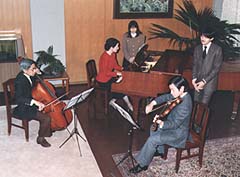
(1987)
(Photo: Imperial Household Agency)
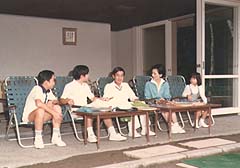
(1978)
(Photo: Imperial Household Agency)
The Empress is fond of music. She plays the piano, and is a good accompanist to the Emperor, who plays the cello and to Crown Prince Naruhito, who plays the viola and violin. When She finds time, She enjoys playing in a small chamber ensemble with Her musician friends. Every summer, Her Majesty participates in the annual Kusatsu International Summer Music Academy and Festival, practicing ensemble performance by playing to the accompaniment of musicians coming from many parts of the world. The Empress also gives encouragement and support to Gagaku, classical court music and dance, often attending the performances by court musicians and dancers, some of whom are descendants of former aristocrats.
Almost every day, the Emperor and Empress take early morning walks in the Palace woods and gardens where they can enjoy the changes of the seasons and be close to nature which they both love. On weekends they play tennis, their favourite sport, when their schedule permits.
Publications Written by Their Majesties Emperor Akihito and Empress Michiko
(Photo: Imperial Household Agency)
Top Row (left to right)
Reprints of the 28 papers on gobiid fishes by Emperor Akihito, mostly written while he was still Crown Prince, and published in the Japanese Journal of Ichthyology by the Ichthyological Society of Japan.
"Some Morphological Characters Considered to be Important in Gobiid Phylogeny," written by Crown Prince Akihito and included in the proceedings of the Second International Conference on Indo-Pacific Fishes which was published in 1986.
Freshwater Fishes in Japan: Their Distribution, Variation and Speciation, written by 19 Japanese ichthyologists, including Crown Prince Akihito. Published by Tokai University Press. (1987)
The Fishes of the Japanese Archipelago, Second Edition, illustrated by more than 30 Japanese ichthyologists, including Crown Prince Akihito. Published by Tokai University Press. (1988)
Fishes of Japan with Pictorial Keys to the Species, Second Edition (2000) and its English edition. (2002)
Second Row (left to right)
"Review of the Gobiid Genus Cristatogobius Found in Japan with Description of a New Species," written by Emperor Akihito for Ichthyological Research by the Ichthyological Society of Japan. (2000)
"Evolutionary Aspects of Gobiid Fishes Based upon a Phylogenetic Analysis of Mitochondrial Cytochrome b Genes" was co-written by the Emperor and other researchers in GENE, an international journal. (2000)
"Early Cultivators of Science in Japan," written by Emperor Akihito for Science. Published by the American Association for the Advancement of Science. (1992)
"The Evolution of Gobiid Fishes," written by Crown Prince Akihito for Kagaku Saron (Salon of Scientists). Published by Tokai University Press. (1984)
Fishes of Japan with Pictorial Keys to the Species, illustrated by 14 Japanese ichthyologists, including Emperor Akihito. Published by Tokai University Press. (1993)
Third Row (left to right)
Hajimete no Yamanobori (My First Mountain), an illustrated book for children written by Empress Michiko, illustrated by Wako Takeda. Published by Shikosha. (1991)
Poems by Michio Mado, selected, translated and arranged by Empress Michiko and entitled Dobutsu-tachi (THE ANIMALS). Published in Japan by Suemori Books and in the United States by Margaret K. McElderry Books. (1992)
Poems by Michio Mado, selected, translated and arranged by Empress Michiko and entitled Fushigina Poketto (THE MAGIC POCKET). Published in Japan by Suemori Books and in the United States by Margaret K. McElderry Books. (1998)
Hashi o Kakeru (Building Bridges), a publication by Suemori Books (1998) of the text on which was based the speech entitled "Reminiscences of Childhood Readings" delivered by Empress Michiko over video linkup to the 26th Congress of IBBY in New Delhi. The book is bilingual.
Bottom Row (left to right)
Tomoshibi: Light, a collection of waka composed by Crown Prince Akihito and Crown Princess Michiko. Published by Fujingahosha (1986) and Weatherhill, Inc. (1991)
Seoto, a collection of 367 poems by Empress Michiko. Published by Daito Publishing Co., Inc. (1997)
With reference to "Their Majesties the Emperor and Empress of Japan 2002" issued by Ministry of Foreign Affairs.